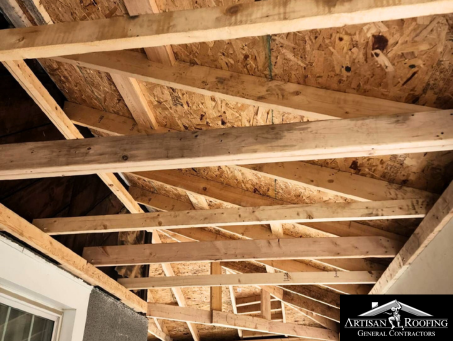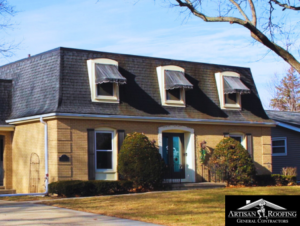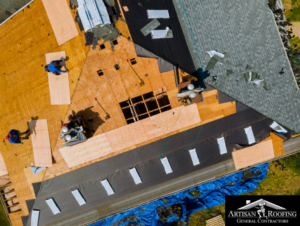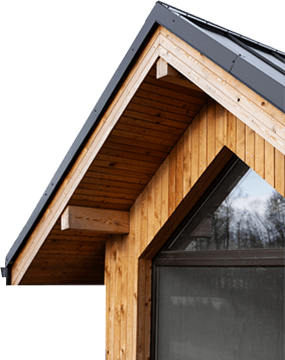When homeowners think about a roofing project, they often envision the visible components like shingles, tiles, or metal that create a finished look and shield the home from rain, snow, and wind. However, the true strength and stability of a roof are often found beneath these exterior materials in an essential, often-overlooked component: the roof sheathing.
This hidden layer, though unseen, serves as the backbone of any roofing system, keeping everything securely in place and adding a vital layer of protection against moisture, wind, and other elements.
In this guide, we’ll dive deep into roof sheathing, covering everything from its purpose and types to the factors that determine when it needs to be replaced. Whether you’re considering a new roof or repairs, or simply want to better understand your home’s structure, understanding roof sheathing can empower you to make informed, long-lasting choices.
1. What Exactly is Roof Sheathing?
Roof sheathing, also known as roof decking, is the foundational layer that supports the outer roofing materials. It typically consists of wooden panels, which are fastened to the roof trusses and joists, providing a stable, solid surface to which the shingles, tiles, or metal roofing can be attached.
Think of it as the “skeleton” of your roof—it’s the layer that holds everything together, allowing the roof to withstand the weight of materials, resist environmental stresses, and keep your home protected.
Beyond providing structural support, roof sheathing plays a role in insulating the roof and protecting it from moisture intrusion.
When installed correctly, it helps distribute weight evenly across the roof and creates a barrier against humidity and water damage, both of which can compromise the integrity of the roof and cause issues like mold, rot, and leaks.
2. Types of Roof Sheathing: What Are Your Options?
Not all roof sheathing is created equal, and different types are suited to various roofing needs and preferences. Here are the two primary types:
1. Plank Sheathing
Plank sheathing is a traditional form of roof sheathing, commonly found in homes built before the widespread use of modern sheet materials. It consists of long, narrow wooden boards (usually 1×6 or 1×8) that are laid across the roof rafters. Though plank sheathing has largely been replaced by sheet options, you may still find it in older homes or specific architectural styles.
Because it can leave small gaps between the planks, plank sheathing isn’t ideal for some modern roofing materials, which require a continuous, solid surface for optimal performance. In older homes, plank sheathing may need reinforcement or even replacement to meet contemporary standards of durability and moisture resistance.
2. Sheet Sheathing
Sheet sheathing has become the standard choice for most modern roofs due to its uniform strength, ease of installation, and compatibility with various roofing materials. Sheet sheathing comes in two main varieties: plywood and Oriented Strand Board (OSB).
- Plywood. Plywood is made from multiple thin layers of wood veneer that are glued together to form strong, durable panels. It’s available in various thicknesses, typically from ⅜ inch to ¾ inch.
Plywood sheathing is particularly popular in regions that experience severe weather since its layered construction makes it more resistant to warping and splitting. While it is generally more expensive than OSB, plywood’s durability and moisture resistance make it a preferred choice for roofs that need extra resilience.
- OSB (Oriented Strand Board). OSB is manufactured by compressing strands of wood with resin to form large, flat panels. It is a cost-effective option and performs similarly to plywood in most roofing applications.
Although OSB is generally cheaper, it is also resilient, widely available, and used extensively in residential roofing. However, some homeowners still prefer plywood due to its established reliability over time, especially in climates with high moisture levels.
3. Why Roof Sheathing Matters for Your Roof’s Strength and Stability
Roof sheathing does much more than simply provide a surface for shingles. It plays a crucial role in ensuring the entire roofing system’s structural integrity, safety, and durability. Here’s why roof sheathing is such an essential part of any roof:
1. Structural Support
Roof sheathing distributes the weight of roofing materials—whether they are shingles, tiles, or metal—across the framework of the house. This support is crucial in preventing sagging, bowing, or collapse, particularly during extreme weather conditions.
Roof sheathing allows the roof to handle heavy loads from snow, ice, and rain without compromising its structural stability. Without this foundational support, roofing materials could fail under stress, leading to serious damage, leaks, and potential safety hazards.
2. Moisture Defense
While shingles or tiles provide the primary barrier against moisture, roof sheathing acts as a secondary defense. Properly installed sheathing ensures water runoff is directed away from vulnerable areas, reducing the likelihood of water seeping through and causing internal damage.
This is especially important in regions with high rainfall or heavy snow, as moisture infiltration can lead to mold, rot, and damage to the structural elements of the house.
3. Fire Resistance
In some cases, roof sheathing materials are treated to be fire-resistant, which can help slow the spread of fire in the event of an emergency.
Fire-resistant roof sheathing materials offer additional protection to your home and can be an essential factor in areas prone to wildfires or high winds that could carry flames.
4. When Does Roof Sheathing Need Replacement?
Over time, roof sheathing can deteriorate due to moisture, temperature fluctuations, and structural wear. Here are some signs that it may be time to replace your roof sheathing:
1. Rotting or Mold
One of the most common issues with roof sheathing is rot, which occurs when moisture penetrates the wood and begins breaking down its fibers. Rot weakens the wood’s structural integrity, making it unable to support roofing materials.
Signs of rot include sagging areas, dark spots, or wood that feels soft or spongy. Mold, which thrives in moist environments, can also be an indication that the sheathing is retaining too much moisture.
2. Warping or Cracks
Extreme weather changes and exposure to the elements can cause roof sheathing to warp or crack over time. Warped or cracked sheathing compromises the stability of the roof and its materials, leading to leaks, gaps, and other structural vulnerabilities.
If you notice any areas of your roof that appear uneven or distorted, it may indicate that the underlying sheathing is compromised.
3. Building Code Requirements
Modern building codes are designed to ensure roofs meet specific safety and performance standards. If your roof has plank sheathing or doesn’t meet certain standards for spacing, thickness, or stability, it may need to be upgraded.
Building codes typically require sheathing with minimal gaps between planks (usually no more than ⅛ inch), as gaps can compromise the effectiveness of nails or fasteners, potentially weakening the entire roofing structure.
5. How Building Codes Affect Roof Sheathing Requirements
Building codes set safety and performance standards that roofs must meet to withstand common hazards like storms, high winds, and heavy snow loads. The 2018 International Residential Code (IRC) provides specific guidelines for roof sheathing, including acceptable materials, thicknesses, and installation practices.
If your roof sheathing doesn’t meet these standards, it may need to be upgraded, especially if you’re planning a major repair or replacement.
For older homes with plank sheathing, building codes may require upgrading to modern sheet sheathing, particularly if there are gaps or structural weaknesses. Upgrading your sheathing ensures a safer, more resilient roof, reduces the risk of leaks, and provides better compatibility with modern roofing materials.
Ignoring these requirements can void your roof’s warranty, complicate future repairs, and even pose safety risks. Meeting code standards is not just about following regulations—it’s about safeguarding your investment and ensuring the longevity of your roof.
6. How Roof Sheathing Impacts the Cost of Roofing Projects
The cost of roof sheathing can vary widely depending on several factors, including the material chosen, the extent of replacement needed, and fluctuations in wood prices. Here’s a closer look at what influences the cost of roof sheathing:
1. Material Choice
- OSB. OSB is generally more affordable than plywood, making it a cost-effective option for many homeowners. However, OSB’s lower price may come with trade-offs in terms of moisture resistance and long-term durability.
- Plywood. Plywood costs more than OSB, but it’s often worth the investment in areas with high humidity or heavy snow. Its durability can justify the higher price, especially in locations where roofs are exposed to extreme weather.
2. Extent of Replacement
The scope of your roofing project will significantly impact the cost. If only a few damaged boards need to be replaced, the expense is minimal. However, if your roof requires a full re-decking, costs will rise considerably due to the additional labor and materials involved.
3. Wood Price Fluctuations
Wood prices can fluctuate due to changes in supply and demand. Periods of high demand or limited supply can lead to higher prices for plywood or OSB. Checking with your contractor about current prices can provide a more accurate estimate for your project.
7. Inspecting Roof Sheathing: Why It Matters
Regular roof inspections allow contractors to assess the condition of your roof sheathing up close, identifying any signs of water damage, warping, or deterioration. A close-up inspection can help you decide if a repair or replacement is needed, ensuring that small problems are addressed before they escalate.
By inspecting sheathing regularly, you can prolong the life of your roof and avoid costly repairs down the line.
8. Final Thoughts: Roof Sheathing as Your Roof’s Foundation
Roof sheathing is a critical yet often overlooked component of a strong and stable roof. While it may be hidden from sight, it serves as the foundation that supports your roof’s durability, insulation, and resistance to weather and fire. Investing in high-quality sheathing, maintaining it properly, and ensuring it meets building code requirements can help prolong the life of your roof and protect your home from structural damage and costly repairs.
Ultimately, understanding the role of roof sheathing empowers homeowners to make more informed decisions when it comes to roof repairs and replacements. A well-installed, robust layer of sheathing will safeguard your home against harsh elements, increase the lifespan of your roofing materials, and provide peace of mind for years to come.
So, the next time you consider a roofing project, remember that the unseen layers, like roof sheathing, are just as important as the visible ones—and they might be the true unsung heroes of your home’s resilience.






